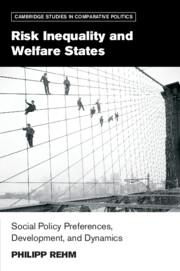Book contents
- Frontmatter
- Dedication
- Contents
- List of Figures
- List of Tables
- Acknowledgments
- 1 Introduction
- 2 Theoretical Framework
- 3 Preference Formation
- 4 Risk Perceptions
- 5 Risk Pools and Social Policy Generosity
- 6 Risk Pools and Retrenchment – German Reunification
- 7 Risk Pools and Social Policy Adoption
- 8 Crises and Social Policy
- 9 Conclusion
- References
- Index
- Other Books in the Series
3 - Preference Formation
Published online by Cambridge University Press: 05 May 2016
- Frontmatter
- Dedication
- Contents
- List of Figures
- List of Tables
- Acknowledgments
- 1 Introduction
- 2 Theoretical Framework
- 3 Preference Formation
- 4 Risk Perceptions
- 5 Risk Pools and Social Policy Generosity
- 6 Risk Pools and Retrenchment – German Reunification
- 7 Risk Pools and Social Policy Adoption
- 8 Crises and Social Policy
- 9 Conclusion
- References
- Index
- Other Books in the Series
Summary
Given the ubiquity of risk management by welfare states one might expect that empirical investigations of the role of risk exposure on social policy attitudes have a long tradition in the field. Yet, while the relationship between risk and social policy at the macro-level has prominently figured in the literature for decades, the first empirical contribution exploring the link between risk and social policy preferences at the micro-level appeared only in 2001 (Iversen and Soskice 2001). This trailblazing study by Torben Iversen and David Soskice focuses on the relationship between social policy attitudes and one particular risk: asset specificity, that is, the degree to which skills are portable across employers. However, the portability of skills is only one of several aspects that contribute to one's risk exposure in the labor market. For example, David Rueda's important work singles out job protection, which varies between labor market insiders and outsiders, and argues that their interests “are fundamentally different” (Rueda 2005, 62). A measure that is broader than “asset specificity,” therefore, seems to be desirable.
The Measurement of Risk Exposure
How can we measure risk exposure in order to test a central micro-level implication of my theoretical framework, namely, that risk exposure correlates with social policy attitudes? Individuals face numerous risks that are – or could be – covered by social insurance programs, ranging from “old risks” (accidents at the workplace, old age, sickness, and unemployment) to “new risks” (lack of skills, single parenthood, domestic care, etc.) (Armingeon and Bonoli 2006; Taylor-Gooby 2005). Ideally, we would want to have – objective and subjective – measures of risk exposure in these different domains (labor market, family, health, retirement) as well as an overall measure of an individual's degree of risk exposure in all realms of life. While one survey (discussed and employed later) moves into that direction, existing domain-specific and overall risk exposure measures are not available cross-nationally, and they are purely subjective. Because my goal is not only to evaluate the impact of risk exposure on social policy attitudes (this chapter) but also to compare and contrast risk distributions across countries and over time (in later chapters), cross-national availability and an objective measure are crucial for my purposes.
- Type
- Chapter
- Information
- Risk Inequality and Welfare StatesSocial Policy Preferences, Development, and Dynamics, pp. 37 - 58Publisher: Cambridge University PressPrint publication year: 2016



